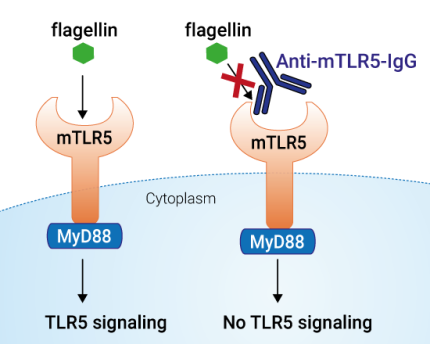Anti-mTLR5-IgG
-
Cat.code:
mabg-mtlr5-2
- Documents
ABOUT
Murine TLR5 Neutralizing antibody - Monoclonal Rat IgG2a
Anti-mTLR5-IgG (clone Q23D11) is a monoclonal antibody specific for murine Toll-like receptor 5 (mTLR5). This monoclonal antibody was produced in hybridoma cells and purified by affinity chromatography.
Anti-mTLR5-IgG has been selected for its ability to efficiently neutralize the biological activity of mTLR5. The neutralizing activity was determined using HEK-Blue™ TLR5 cells. TLR5 recognizes flagellin from Gram-positive and Gram-negative bacteria. Activation of the receptor stimulates the production of proinflammatory cytokines through signaling via the adaptor protein MyD88.
Key features:
- Reacts with murine TLR5
- Provided azide-free
- Each lot is functionally tested
![]() Read our review on Toll-Like Receptors.
Read our review on Toll-Like Receptors.
All products are for internal research use only, and not for human or veterinary use.
SPECIFICATIONS
Specifications
mTLR5
Neutralization of murine TLR5-induced cellular activation
0.2 µm filtered solution in a sodium phosphate buffer with saccharose, glycine, and stabilizing agents
Each lot is functionally tested and validated.
CONTENTS
Contents
-
Product:Anti-mTLR5-IgG
-
Cat code:mabg-mtlr5-2
-
Quantity:2 x 100 µg
Shipping & Storage
- Shipping method: Room temperature
- -20°C
- Avoid repeated freeze-thaw cycles
Storage:
Caution:
Details
Toll-like receptors (TLRs) play a critical role in early innate immunity to invading pathogens by sensing microorganisms. These evolutionarily conserved receptors recognize highly conserved structural motifs only expressed by microbial pathogens, called pathogen-associated microbial patterns (PAMPs). Stimulation of TLRs by PAMPs initiates a signaling cascade leading to the secretion of proinflammatory cytokines following NF-κB activation. To date ten human and twelve murine TLRs have been characterized, TLR1 to TLR10 in humans, and TLR1 to TLR9, TLR11, TLR12, and TLR13 in mice, the homolog of TLR10 being a pseudogene.
TLR5 recognizes flagellin from both Gram-positive and Gram-negative bacteria. Activation of the receptor stimulates the production of proinflammatory cytokines, such as TNF-α, through signaling via the adaptor protein MyD88 and the serine kinase IRAK [1-3]. TLR5 can generate a pro-inflammatory signal as a homodimer suggesting that it might be the only TLR participating in flagellin recognition [3]. However, TLR5 may require the presence of a co-receptor or adaptor molecule for efficient ligand recognition and/or signaling [4].
1. Yang J. & Yan H. 2017. TLR5: beyond the recognition of flagellin.Cell Mol Immunol. 14(12):1017-1019.
2. Gewirtz AT. et al., 2001. Cutting edge: bacterial flagellin activates basolaterally expressed TLR5 to induce epithelial proinflammatory gene expression. J Immunol. 167(4):1882-5.
3. Hayashi F. et al., 2001. The innate immune response to bacterial flagellin is mediated by Toll-like receptor 5. Nature. 410(6832):1099-103.
4. Tallant T. et al., 2004. Flagellin acting via TLR5 is the major activator of key signaling pathways leading to NF-kappa B and proinflammatory gene program activation in intestinal epithelial cells. BMC Microbiol. 4(1):33.
DOCUMENTS
Documents
Technical Data Sheet
Validation Data Sheet
Safety Data Sheet
Certificate of analysis
Need a CoA ?

